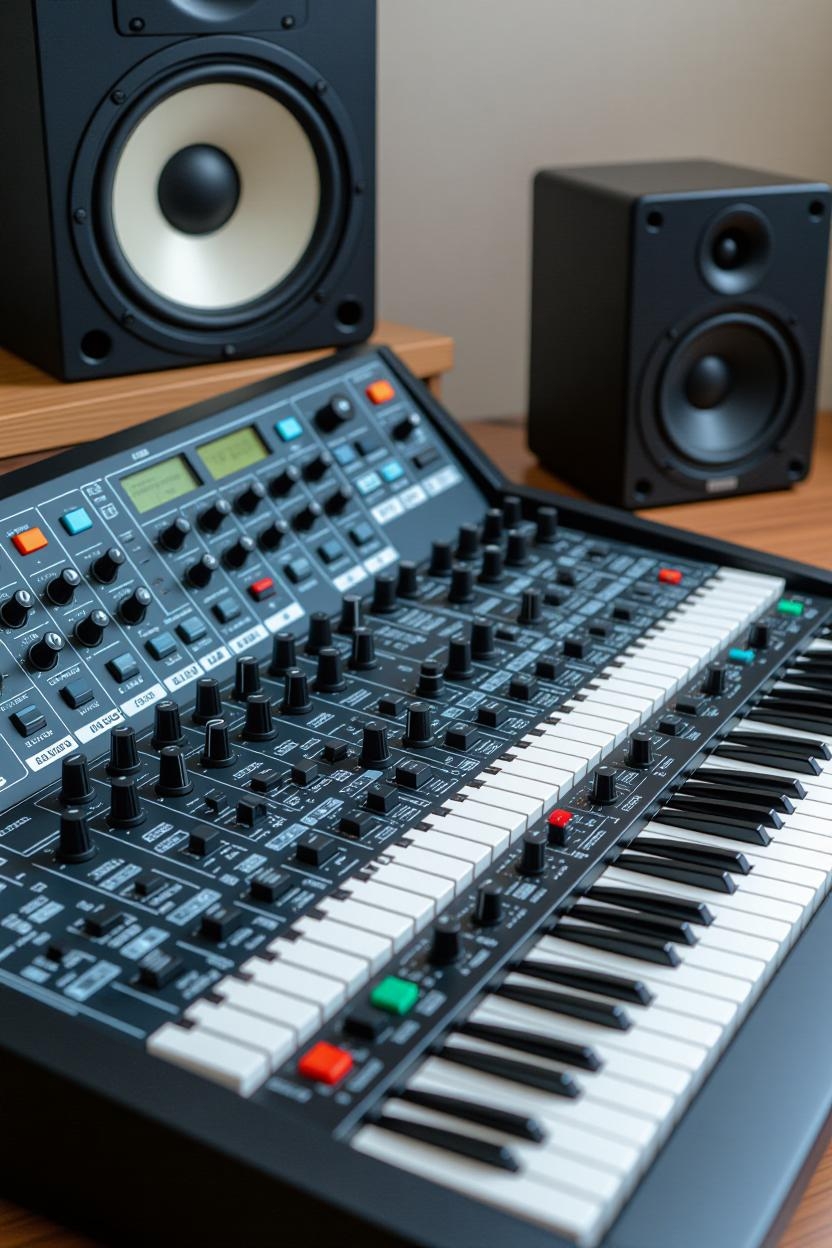Stem Splitter: High Audio and Video Processing
 In the world of digital content, where music and video are integral to daily life, tools for editing sound and visuals play a pivotal role. One of the most innovative approaches is the separation of audio tracks into individual components, known as stems. These technologies allow musicians, producers, and video editors to extract vocals, drums, or bass from a finished composition, opening new horizons for creativity. In this article, we’ll explore how these tools work, their integration into popular audio and video editors, and highlight some of the standout solutions in the market. If you’re passionate about sound processing or content creation, this guide will help you better understand the evolution of the industry.
In the world of digital content, where music and video are integral to daily life, tools for editing sound and visuals play a pivotal role. One of the most innovative approaches is the separation of audio tracks into individual components, known as stems. These technologies allow musicians, producers, and video editors to extract vocals, drums, or bass from a finished composition, opening new horizons for creativity. In this article, we’ll explore how these tools work, their integration into popular audio and video editors, and highlight some of the standout solutions in the market. If you’re passionate about sound processing or content creation, this guide will help you better understand the evolution of the industry.
Stem splitters do more than simplify audio work—they transform the entire production process. Imagine taking a favorite song and isolating just the guitar for a remix or removing noise from a video. Such possibilities have become reality thanks to artificial intelligence that analyzes sound waves and separates elements. In the context of video editors, this is particularly valuable for syncing audio with visuals or enhancing soundtrack quality. We’ll discuss how these tools fit into the ecosystem of editing software and why they’ve become a must-have for professionals.
What is a Stem Splitter and How Does It Work?
A stem splitter is specialized software designed to divide a mixed audio track into individual stems, such as vocals, drums, bass, and other instruments. At its core lies a machine-learning algorithm that recognizes patterns in sound and isolates them. For instance, it analyzes frequencies: low for bass, high for vocals, and rhythmic for drums. This differs from traditional audio editors, where separation required manual work with equalizers or filters.
The process of using a stem splitter is typically straightforward: users upload a file, select separation options, and within minutes receive individual tracks. These tools have evolved from simple vocal removers to comprehensive systems capable of handling complex compositions. In video editors like Adobe Premiere or Final Cut Pro, integrating such features enables soundtrack editing without compromising visual quality. A prime example is their use in podcasts, where isolating speech from background music is essential.
However, not all stem splitters are equally effective. Some rely on cloud computing for better accuracy, while others work locally. The quality of the output depends on the source audio: clean recordings yield better stems. Overall, these tools democratize access to professional audio processing, making it available even to beginners in audio and video editing.
Benefits of Using Stem Splitters in Creative Work
Stem splitters offer numerous advantages for musicians and video producers. First, they speed up the remix process: instead of re-recording tracks, you can modify existing material. This is particularly useful in genres like EDM or hip-hop, where sampling is a cornerstone of creativity. In video editors, these tools help synchronize audio with visuals, removing unwanted elements without disrupting the overall structure.
Another benefit is improved quality. Stem separation allows for targeted adjustments: boosting bass in a video or removing echo from vocals. For podcasters and YouTubers, this means cleaner sound without expensive equipment. Additionally, these tools encourage experimentation: imagine combining stems from different songs for a unique video soundtrack.
In the context of audio editors like Audacity or GarageBand, integrating stem splitters expands functionality. Users can import separated tracks and work with them independently, simplifying mixing. However, there are limitations: not all tools are free, and some require subscriptions. Nevertheless, the benefits outweigh the drawbacks, making stem splitters indispensable in today’s digital landscape.
- Faster Production: Quick extraction of elements reduces editing time.
- Creative Flexibility: Enables experimentation with stem combinations.
- Accessibility for Beginners: Intuitive interfaces require minimal expertise.
- Video Integration: Enhances soundtracks for editing.
- Resource Efficiency: Eliminates the need to re-record tracks.
Top Stem Splitter Tools in the Market
Among the standout stem splitters, LALAL.AI is renowned for its precision in isolating vocals and instruments. This online tool uses AI to process audio and video files, offering options to split into up to six stems. Users praise its speed and quality, especially for remixes. Another leader, Moises.AI, integrates with mobile apps and supports video soundtrack processing.
Hit’n’Mix RipX DAW combines stem separation with a full-featured audio editor, allowing users to edit notes within stems. This is ideal for musicians diving deep into composition. Gaudio Studio focuses on vocal removal but also handles full separation, supporting direct YouTube video processing.
Аnother noteworthy tool in the stem splitting landscape is EaseUS Vocal Remover, designed for both beginners and professionals. This online platform excels at isolating vocals from instrumental tracks, making it a favorite for karaoke enthusiasts and remix creators. Its intuitive interface allows users to upload audio or video files and quickly separate stems with minimal effort. EaseUS also supports multiple formats, including MP3 and WAV, and integrates seamlessly with video editing workflows, such as enhancing audio for YouTube content or short films. While its free version offers basic functionality, the premium plan unlocks advanced AI models for cleaner separations, making it a versatile choice for content creators looking to refine their audio without complex setups.
AudioStrip and LANDR offer cloud-based solutions with a focus on professional quality. LANDR, in particular, integrates with video editors for soundtrack mastering. Spleeter by Deezer is an open-source option popular among developers looking to customize the process. Ultimate Vocal Remover (UVR) is free and leverages advanced AI models for precise separation.
| Stem Splitter | Key Features | Pricing | Video Support |
| LALAL.AI | Splits into 6 stems, AI analysis | Free/Subscription from $10/month | Yes |
| Moises.AI | Mobile integration, remixing | Free/Premium $4/month | Yes |
| RipX DAW | Note editing, full DAW | $99 (one-time) | Partial |
| Gaudio Studio | Vocal remover, YouTube support | Free/Premium | Yes |
| LANDR | Mastering, cloud storage | Subscription from $12/month | Yes |
| EaseUS Vocal Remover | Vocal isolation, multi-format support | Free/Premium | Yes |
Integration of Stem Splitters in Audio Editors
Audio editors have evolved, incorporating stem separation to streamline workflows. For instance, Apple Logic Pro 11 includes a built-in stem splitter that divides tracks into vocals, drums, bass, and more directly in the interface. This allows musicians to work with separated elements without external tools. Similarly, FL Studio 21.2 offers a stem separation plugin integrated with its mixer for real-time processing.
iZotope RX is a professional choice for audio restoration, where stem splitters aid in removing noise from individual stems. In Audacity, an open-source editor, users can add plugins like Spleeter for similar functionality. These integrations make audio editors versatile, especially for video producers importing soundtracks.
In video editing, DaVinci Resolve combines audio tools with Fairlight, where stem separation enhances post-production. This allows sound editing independent of video, improving the final product. Notable examples include its use in films for sound design or in music for live mixes.
- Upload the audio file to the editor.
- Activate the stem separation function.
- Select the desired stems to extract.
- Edit each stem individually.
- Export the result for further use.
Stem Splitters in Video Editors: New Opportunities
 Video editors increasingly incorporate audio tools, including stem splitters. Adobe Premiere Pro, for example, integrates with Adobe Audition, where stem splitters isolate dialogues from music in videos. This is critical for editing films or clips where sound clarity is paramount. Final Cut Pro leverages Logic Pro’s stem splitter for similar tasks, simplifying synchronization.
Video editors increasingly incorporate audio tools, including stem splitters. Adobe Premiere Pro, for example, integrates with Adobe Audition, where stem splitters isolate dialogues from music in videos. This is critical for editing films or clips where sound clarity is paramount. Final Cut Pro leverages Logic Pro’s stem splitter for similar tasks, simplifying synchronization.
In free editors like CapCut or iMovie, plugins for stem separation are being added, making them accessible to YouTubers. These features aid content creation: removing background noise or enhancing vocals in vlogs. BandLab’s Splitter integrates with mobile video apps for editing on the go.
The benefits are clear: better synchronization, time savings, and professional audio without a studio. Challenges include format compatibility and processing power. In the future, deeper AI integration is expected for automated video audio enhancement.
| Video Editor | Stem Splitter Integration | Key Benefits | Pricing |
| Adobe Premiere Pro | Via Audition | Professional editing | Subscription $20/month |
| Final Cut Pro | Built-in from Logic | Fast processing | $299 (one-time) |
| DaVinci Resolve | Fairlight integration | Free version available | Free/Studio $299 |
| CapCut | Stem plugins | Mobile accessibility | Free |
| iMovie | Basic integration | Beginner-friendly | Free |
The Future of Stem Splitters and Their Industry Role
The future of stem splitters promises even greater accuracy with advanced AI. Real-time video processing is expected, integrating with AR/VR for immersive content. In audio editors like Ableton Live, stem separation will become standard for live performances.
Notable trends include open-source developments like Demucs, enabling customization. In video, this means automated soundtrack enhancement for streaming. However, ethical concerns, such as copyright issues with stems, will gain prominence.
- Real-time processing for live performances.
- AR/VR integration.
- Improved accuracy for complex tracks.
- Open-source innovations.
- Focus on sustainability (less energy for computation).
Tips for Choosing and Using a Stem Splitter
When selecting a stem splitter, consider your needs: LALAL.AI is great for music, while Moises.AI suits video. Ensure compatibility with your audio or video editor. Free options like UVR are ideal for testing, but premium tools offer better quality. EaseUS Vocal Remover is a solid choice for those prioritizing ease of use and multi-format support, especially for video content creators.
Experiment with different AI models for optimal results. In practical guides, avoid overloading with jargon, focusing on simplicity. Regularly update software for new features.
| Selection Criterion | Recommendations | Examples |
| Separation Quality | Look for AI-driven models | LALAL.AI, iZotope RX, EaseUS Vocal Remover |
| Pricing | Free vs. Premium | UVR (free), RipX ($99), EaseUS (Free/Premium) |
| Integration | With audio/video editors | Logic Pro, Premiere, EaseUS |
| Accessibility | Online vs. Local | Gaudio (online), Spleeter (local), EaseUS (online) |
| Format Support | MP3, WAV, Video | Most tools support |
In conclusion, stem splitters are revolutionizing audio and video processing, making creativity accessible. By integrating with popular editors, they enable unique content creation. Experiment and unlock new possibilities!







